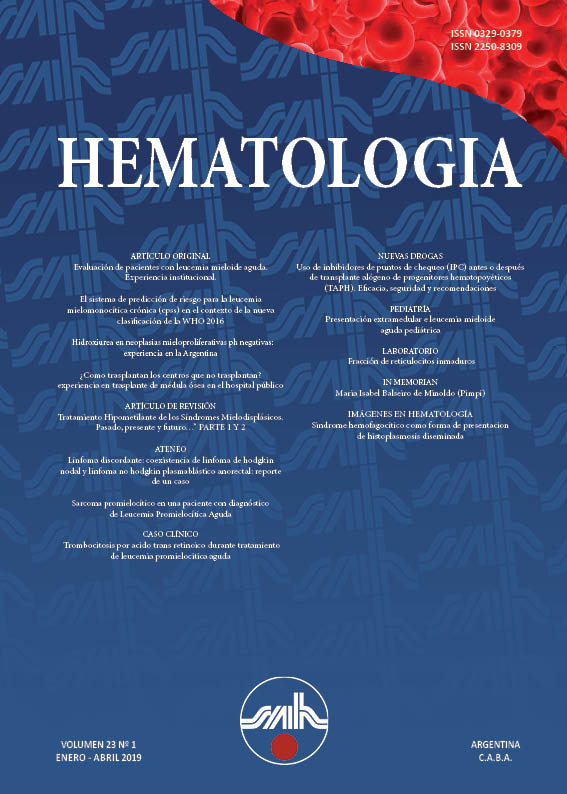Abstract
Hematological malignancies are frequently severe and aggressive diseases that require an intensive strategy for their management. Bone marrow transplantation (BMT) is in many cases the only way to achieve cure or prolonged survival. In the present time, there is not a formal program for BMT for people with hematologic diseases in public health services. To achieve a transplant for a patient requires a complex administrative process to get a subsidy from the State, making access not equal for every patient. The aim of this analysis is to describe the clinical and socioeconomic characteristics, the time to transplant, sources of financial support and explore its possible association with survival in a cohort of unselected patients from a Public Hospital in Buenos Aires City (CABA) that underwent a BMT from 2000 to 2017. We also analyze data from a briefly time registry, evaluating those BMT performed / not performed and their possible causes.
During this period 88 patients underwent BMT, 50 autologous and 38 allogeneic (8 where unrelated and 6 haploidentical). Financing was supported by State (CABA) in 40.9%. Time to transplantation was larger in patients without any other insurance than Public Hospital (8,37 vs. 3,8 month for those who did have insurance), and more patients in this group tend to fail achieving BMT than those with another kind of funding than the State.
Access of all kinds of patients is improving on last years as number of BMT done in our patients is increasing.
Given the small number of patients and the heterogeneity of each group in terms of diagnoses and type of BMT, no other statistical significant analysis could be made. Efforts are being made to change the complex administrative procedures to achieve BMT for those patients who are completely dependent on the public health system of the city government of Buenos Aires, and also to register the real needs of transplants of our population. Probably these changes will improve the unequal access to best therapeutics tools of all patients.
References
2. Passweg JR, Baldomero H, Bader P et al, for the European Society for Blood and Marrow Transplantation (EBMT). Use of haploidentical stem cell transplantation continues to increase: the 2015 European Society for Blood and Marrow Transplant activity survey report. Bone Marrow Transplantation (2017) 52, 811-817.
3. Gertz A et al. How we manage autologous stem cell transplantation for patients with multiple myeloma. Blood. 2014 Aug 7; 124(6): 882-890.
4. Fischman L, González J, Verri V y col. Trasplante de Células Progenitoras Hemopoyéticas: Experiencia y dificultades en un Hospital Público. Experiencia de los últimos diez años. XXI Congreso Argentino de Hematología. 2013. Poster.
5. Flowers Ch et al. Efficacy of Pharmacokinetics-Directed Busulfan, Cyclophosphamide, and Etoposide Conditioning and Autologous Stem Cell Transplantation for Lymphoma: Comparison of a Multicenter Phase II Study and CIBMTR Outcomes. Biol Blood Marrow Transplant. 2016 Jul; 22(7): 1197-1205).
6. Cairo MS. NCI first International Workshop on the biology, prevention and treatment of relapse after allogeneic hematopoietic stem cell transplantation: report from the committee on the biological considerations of hematological relapse following allogeneic stem cell transplantation unrelated to graft-versus-tumor effects: state of the science. Biol Blood Marrow Transplant. 2010 Jun; 16(6): 709-728.).
7. Navneet S et al. Access to hematopoietic cell transplantation in the United States. Biol Blood Marrow Transplant. 2010 August; 16(8): 1070-1075).
8. Mitchell JM et al. Access to bone marrow transplantation for leukemia and lymphoma: the role of sociodemographic factors. J Clin Oncol. 1997; 15:2644-2651.
9. Jaimovich G, Martínez Rolon J, Baldomero H et al. Latin America: the next region for haematopoietic transplant progress. Bone Marrow Transplant. 2017 May;52(5):671-676.
All material published in the journal HEMATOLOGÍA (electronic and print version) is transferred to the Argentinean Society of Hematology. In accordance with the copyright Act (Act 11 723), a copyright transfer form will be sent to the authors of approved works, which has to be signed by all the authors before its publication. Authors should keep a copy of the original since the journal is not responsible for damages or losses of the material that was submitted. Authors should send an electronic version to the email: revista@sah.org.ar

